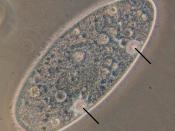Interorganismal Transport System in Paramecium
Common Name: Paramecium
Kingdom Protista
Phylum: Ciliophora
Class: Paramecium Caudatum
Paramecium are an exceedingly fascinating group of the ciliophora phylum. Paramecium are eukaryotic cells. They contain membrane bound nuclei, "DNA that is associated with histone proteins " and organelles (Encyclopedia.com, "Paramecium"). All paramecium are composed of only one cell (Encyclopedia.com, "Paramecium"). However that single cell contains several important organelles that contribute to a network of vital processes. Paramecium live in freshwater, typically in ponds or leisurely streams (World Book Online, "Paramecium"). They are unique in that for being so simple they have much more complex transport systems than other unicellular organisms. They have organelles that function similar to stomachs and they also have a distinct path on which the nutrients circulate. (Campbell, 799) (Cellular Digestion, 1). The diagram below illustrates in red the path the nutrients take to distribute the necessities to the rest of the cell.
Also in the following diagram, you can see the "stomach" like structure called the Lysosome (Cellular Digestion, 1). Other simpler organisms, such as bacteria or fungi, lack these important organelles and must digest their food by other means. Additionally marked, in blue, is the path the nutrients take when absorbed through the 'Oral-Groove' as it is commonly known, and passed through a system in the cell. This more developed transport system in Paramecium allow them to live relaxed lives in their freshwater ponds obtaining food easily throughout their entire lifetime.
In my first lab I observed Paramecium Caudatum on a very basic, outline power level, 40 x magnification. Once I found the moving Paramecium, I immediately noticed its oval shape. I additionally noted a blurry outline which I speculate to be the cilia when compared to other Textbook diagrams of the organism (Miller, 385). I saw...


